
Three U.S. cities now get all of their power from renewables. You’re probably thinking that they’re all in California, but surprisingly, none of them are.
The first city to achieve this status was Burlington, Vermont. Burlington made its announcement back at the beginning of this year. Taking advantage of local forests, the city gets a large share of power from the McNeil Generating Station that has been burning locally-sourced wood ships for 30 years. To this was added a new hydro plant, considerable wind power and a smaller amount of solar. All this has been achieved without raising rates.
The second city, was tiny Greenburg, Kansas, (population 1,400) which now uses the same wind that destroyed the town in a tornado back in 2007 to provide most of its power. In 2009, the town made a 20-year power purchase agreement with Exelon Corp., for a 12.5 megawatt wind farm, more than enough to supply every house, business and municipal building in the town.
In fact, two-thirds of the wind farm’s output is excess power. It goes back into the grid as renewable energy credits for other Kansas Power Pool customers. Other wind turbines serve the hospital, school, arts center and a local hotel. The city also uses hydro, ground-source heat pumps, small solar PV and LED street lighting, to maintain its 100 percent renewable status.
The latest city to reach this milestone is Aspen, Colorado. The shift to energy that is generated from natural resources — including wind power, solar power and geothermal heat — follows a “decade-plus” goal, said city utilities and environmental initiatives director, David Hornbacher. Aspen is one of three U.S. cities to run on 100 percent renewable energy, according to members of the city’s environmental and project departments.
“It was a very forward-thinking goal and truly remarkable achievement,” Hornbacher said. “This means we are powered by the forces of nature, predominately water and wind with a touch of solar and landfill gas.”
Aspen residents have some bragging rights here, too, considering that they installed the first hydroelectric system West of the Mississippi back in the 1885. It's been mostly renewables all along.
But it was the hydropower projects from Ruedi Reservoir, Maroon Creek and Ridgway Reservoir, which is near Montrose, that really put the 100 percent goal within reach.
In 2005, the city created the Canary Initiative, which identifies Aspen and other mountain communities as “canaries in the coal mine” with respect to their sensitivity to the effects of climate change. Aspen relies on a stable climate and thriving natural environment for its economic viability and quality of life.
Still, last year, the city was stuck at 86 percent renewables. But last week, the final piece of the puzzle was put into place. That’s when the city signed a contract with wholesale electric energy provider Municipal Energy Agency of Nebraska. In this final piece, four wind farms, located in Nebraska and South Dakota, provide enough energy to account for 20 to 25 percent of the total supply, replacing coal with wind power.
“We’ve demonstrated that it is possible” and that a small, progressive community can work together to be a pathway for others, Hornbacher said. “Realistically, we hope we can inspire others to achieve these higher goals.”
Canary Initiative Director Ashley Perl agreed with Hornbacher, that it’s important for Aspen to reduce its environmental footprint, “but it’s more important to share that to be able to inspire others.”
Perl said the city plans to launch both a big national campaign and a local celebration, including an “Aspen electric-pride party so that everyone can show their support and really be proud of what we’ve accomplished as a community.”
Image credit: Flickr/KR1212

RP Siegel (1952-2021), was an author and inventor who shined a powerful light on numerous environmental and technological topics. His work appeared in TriplePundit, GreenBiz, Justmeans, CSRWire, Sustainable Brands, Grist, Strategy+Business, Mechanical Engineering, Design News, PolicyInnovations, Social Earth, Environmental Science, 3BL Media, ThomasNet, Huffington Post, Eniday, and engineering.com among others . He was the co-author, with Roger Saillant, of Vapor Trails, an adventure novel that shows climate change from a human perspective. RP was a professional engineer - a prolific inventor with 53 patents and President of Rain Mountain LLC a an independent product development group. RP was the winner of the 2015 Abu Dhabi Sustainability Week blogging competition. RP passed away on September 30, 2021. We here at TriplePundit will always be grateful for his insight, wit and hard work.














